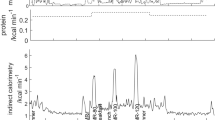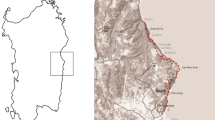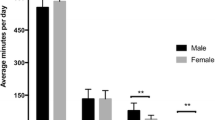Abstract
The aim of this study was to evaluate changes in physical activity, aerobic performance, and body composition in polar explorers during a 1-year stay at the polar station. The study group consisted of 10 people, including 8 men and 2 women. Aerobic performance (maximal oxygen uptake), physical activity, body mass, and composition were evaluated for the polar explores of the Polish Polar Station prior to departure, and then during their stay at the station for a period of 1 year. The measurements were performed every 3 months. Compared to the measurements taken before going to the polar station, aerobic performance significantly (p = 0.02) increased in the first 3 months of residing at the polar station and then remained relatively stable for the following duration of the stay. In the first 3 months of the stay, we also observed the highest level of physical activity in participants. In the polar explorers, no significant (p > 0.05) body fatness changes were noted. Nonetheless, lean body mass, body mass, and BMI significantly increased compared to the measurements taken before departure to the polar station. The greatest changes in aerobic performance, physical activity, and body composition were observed during the first 3 months after arrival to the Arctic and then, despite changing biometeorological conditions, they remained stable for the next months of the stay. We recommend the introduction of a physical preparation program before departing to the polar station to improve explorers’ physical fitness, so that they can meet the physical challenges they are faced with immediately after arrival to the polar station.
Similar content being viewed by others
References
Acheson KJ, Campbell IT, Edholm OG, Miller DS, Stock MJ (1980) A longitudinal study of body weight and body fat changes in Antarctica. Am J Clin Nutr 33:972–977
Araźny A (2008) Bioclimatic conditions and their variability in the Norwegian Arctic for the period 1971–2000. Nicolaus Copernicus University Press, Toruń. (in Polish)
Araźny A, Migała K, Sikora S, Budzik T (2010) Meteorological and biometeorological conditions in the Hornsund area (Spitsbergen) during the warm season. Pol Polar Res 31:217–238. doi:10.2478/v10183-010-0002-4
Belkin V, Karasik D (1999) Anthropometric characteristics of men in Antarctica. Int J Circumpolar Health 58:152–169
Bhatia A, Pal R (2013) Impact of Antarctica winters on vital parameters and anthropometric variables. Travel Med Infect Dis 11:170–177. doi:10.1016/j.tmaid.2013.02.005
Bittel J (1992) The different types of general cold adaptation in man. Int J Sports Med 13:S172–S176. doi:10.1055/s-2007-1024630
Chen N, Wu Q, Li H, Zhang T, Xu C (2016) Different adaptations of Chinese winter-over expeditioners during prolonged Antarctic and sub-Antarctic residence. Int J Biomet 60:737–747. doi:10.1007/s00484-015-1069-8
Conway GA, Husberg BJ, Lincoln JM (1998) Cold as a risk factor in working life in the circumpolar regions. In: Holmer I, Kuklane K (eds) Problems with cold work 18. Arbate och Hälsa, National Institute for Working Life, Solna
Dehghan M, Merchant AT (2008) Is bioelectrical impedance accurate for use in large epidemiological studies. Nutr J 7:7–26. doi:10.1186/1475-2891-7-26
Dick AF (1985) Fitness changes in an Australian Antarctic expedition. Eur J Appl Physiol Occup Physiol 54:191–195. doi:10.1007/BF02335928
Gavhed D (2003) Human responses to cold and wind, Arbete och Hälsa 4, National Institute for Working Life, Stockholm
Gross LD, Sallis JF, Buono MJ, Roby JJ, Nelson JA (1990) Reliability of interviewers using the seven-day physical activity recall. Res Q Exerc Sport 61:321–325. doi:10.1080/02701367.1990.10607494
Majumdar D, Purkayastha SS, Selvamurthy W (1994) Body weight and skin fold thickness in Antarctica. Ninth Indian Expedition to Antarctica, Scientific Report, Department of Ocean Development. Technical Publication 6:259–268
Margaria R, Aghemo P, Rovelli E (1965) Indirect determination of maximal O2 consumption in man. J Appl Physiol 20:1070–1073
Otani S, Ohno G, Shimoeda N, Mikami H (2004) Morbidity and health survey of wintering members in Japanese Antarctic research expedition. Int J Circumpolar Health 63:165–168. doi:10.3402/ijch.v63i0.17890
Palinkas LA, Suedfeld P (2008) Psychological effects of polar expeditions. Lancet 371(9607):153–163. doi:10.1016/S0140-6736(07)61056-3
Parker RH (1985) Physiological adaptations and activity recorded at a polar base. Eur J Appl Physiol Occup Physiol 54:363–370. doi:10.1007/BF02337179
Przybylak R, Araźny A, Nordli Ø, Finkelnburg R, Kejna M, Budzik T, Migała K, Sikora S, Puczko D, Rymer K, Rachlewicz G (2014) Spatial distribution of air temperature on Svalbard during 1 year with campaign measurements. Int J Climatol 34:3702–3719. doi:10.1002/joc.3937
Sallis JF, Haskell WL, Wood PD, Fortmann SP, Rogers T, Blair SN, Paffenbarger RS (1985) Physical activity assessment methodology in the Five-City Project. Am J Epidemiol 121:91–106
Sallis JF, Haskell WL, Fortmann SP, Vranizan KM, Taylor CB, Solomon DS (1986) Predictors of adoption and maintenance of physical activity in a community sample. Prev Med 15:331–341. doi:10.1016/0091-7435(86)90001-0
Sarkin J, Campbell J, Gross L, Roby J, Bazzo S, Sallis J, Calfas K (1997) Seven-day physical activity recall. Med Sci Sports Exerc 29(suppl. 6):89–103
Simpson A (2010) The effect of Antarctic residence on energy dynamics and aerobic fitness. Int J Circumpolar Health 69:220–235. doi:10.3402/ijch.v69i3.17625
Simpson A, Maynard V (2012) A longitudinal study of the effect of Antarctic residence on energy dynamics and aerobic fitness. Int J Circumpolar Health 71:17227. doi:10.3402/ijch.v71i0.17227
Styszyńska A (2013) Results of observations. In: Marsz AA, Styszyńska A (eds) Climate and climate change at Hornsund, Svalbard. Gdynia Maritime University, Gdynia, pp. 321–365
Tanaka H, Monahan KD, Seals DR (2001) Age-predicted maximal heart rate revisited. J Am Coll Cardiol 37:153–156. doi:10.1016/S0735-1097(00)01054-8
Wilson O (1960) Changes in body-weight of men in the Antarctic. Brit. J Nutr 14:391–401. doi:10.1079/BJN19600050
Acknowledgments
This research was supported by the Polish-Norwegian Fund as part of the Arctic climate system study of ocean, sea ice, and glacier interactions in Svalbard area project (AWAKE 2) and National Center for Research and Development (Poland). The authors would like to thank the subjects who volunteered for this study. Data were gathered during the 37th Polar Expedition (Polish Academy of Sciences, Institute of Geophysics) to Spitsbergen.
Author information
Authors and Affiliations
Corresponding author
Ethics declarations
Informed consent
Informed consent was obtained from all individual participants included in the study.
Conflict of interest
The authors declare that they have no conflict of interest.
Rights and permissions
About this article
Cite this article
Maciejczyk, M., Araźny, A. & Opyrchał, M. Changes in aerobic performance, body composition, and physical activity in polar explorers during a year-long stay at the polar station in the Arctic. Int J Biometeorol 61, 669–675 (2017). https://doi.org/10.1007/s00484-016-1244-6
Received:
Revised:
Accepted:
Published:
Issue Date:
DOI: https://doi.org/10.1007/s00484-016-1244-6




